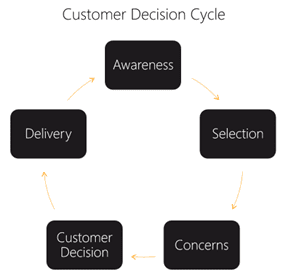If you are too focused on following your own sales process, you could risk losing the sale…
As a sales consultancy, we’re often asked to support our clients in overcoming the challenges they face when selling to their own customers. As part of our approach, we’ll ask our clients about their sales process – what it looks like, where they’re experiencing challenges etc.
Is your Selling Process hindering you?
Now let’s be clear, having a defined sales process is great. A well-defined sales process should help drive a consistent approach across the sales organisation, and amongst other things support more effective forecasting and pipeline management.
In our experience though, having a clearly defined sales process can sometimes also present a risk. Consultative sales organisations pride themselves on their customer focus; their ability to step into the customer’s shoes – to see the world from the customer’s perspective.
All too often though, salespeople become so focused on navigating the steps in their seller-centric process, they can forget that truly effective selling should be a collaboration between customer and salesperson. They get so hung up on progressing through the steps of the selling journey that they forget to regularly check-in and ask themselves the question ‘Is the customer ready to move to the next stage yet?’
So whilst many sales organisations claim true customer focus, their behaviour often suggests otherwise – particularly if their activities are driven by a sales-centric selling process.
Reflect on your own experiences as a customer. Have you ever found yourself in conversation with a ‘pushy’ salesperson? What makes them pushy? Possibly the fact that whilst they’re looking to drive you towards some kind of close you may not yet be convinced that you even have a need, let alone that their offering would be your solution of choice.
Which is why we encourage our clients to think not just about the steps within their own sales process, but critically to consider the journey the customer is experiencing in making their buying decision.
At Flame Learning, we tend to focus on the buying process in order to inform the behaviours that a salesperson should demonstrate at any point in time. The Customer Decision Cycle is a customer-centric approach to helping customers buy rather than feel like they’re being sold to.
What is the Customer Decision Cycle?
Rather than highlighting the activities we adopt to SELL to the customer, it maps the journey the customer navigates in order to BUY.

The framework enables salespeople and account managers alike to match their behaviours according to the customer’s position in the Cycle. In doing so, we’re more likely to build long-term, trust-based relationships and increase the influence we have on purchasing decisions.
Customer Decision Cycle: Awareness
The first phase of the Decision Cycle is Awareness. Awareness is simply recognition by the customer that they have some kind of need. Unless the customer is aware that there is both urgency and importance around meeting the need, it’s unlikely that they’ll move any further in their buying journey. So in this phase the effective salesperson or account manager should help the customer recognise the urgency and importance around the need to change.
However, recognition that there’s a need to be met is no guarantee that they’ll be choosing your solution!
Customer Decision Cycle: Selection
Think about any significant purchase you’ve made. If you’ve decided you need a new car, do you buy the first one you see advertised? Unlikely. Most of us create a list of buying criteria that enable us to select the best option – that list can be created consciously or sub-consciously. We’ll then weigh-up the various options against those criteria to see which solution best meets our needs. That’s the Selection phase. Here we work with the customer to; identify their buying criteria, how we stack up against those criteria and to execute strategies to improve our competitive standing.
By the end of the Selection phase the customer will have a front-runner in mind. So are they now ready to commit? Maybe…or maybe not. Have you ever been in a situation where you think you’ve done a great job of convincing the customer that your products and services are the best-fit, only to find that everything goes quiet, or that they stop returning your calls? Or maybe the customer suddenly introduces someone else from their organisation who you’ve never met or heard of before?
Customer Decision Cycle: Concerns
If that’s the case, there’s a good chance that they have some concerns about moving forward. Maybe they’re considering the risks of investing in the solution.
If those concerns aren’t managed appropriately there’s a good chance they won’t be making a buying decision in your favour. If however their concerns and worries are handled effectively they’re well placed to make the purchase. So the effective sales organisation makes sure they first identify any worries or concerns the customer has and then puts plans in place to alleviate those worries or concerns. And by the way, those worries aren’t just confined to the Concerns phase of the Decision Cycle – they can appear at any stage – it’s simply that if they haven’t been handled by the time the customer reaches their Decision phase, it’s highly unlikely they’ll be making a positive decision in our favour.
Customer Decision Cycle: Customer Decision
If you’ve done a comprehensive and compelling job in the Awareness, Selection and Concerns phases, you put yourself in a strong position for the customer to make a buying Decision in your favour.
That’s not to say though that some final skilled negotiation may not still be required to push the deal over the line.
Customer Decision Cycle: Delivery
The story doesn’t end there though. Through the cycle, expectations will have been built in the customer’s mind around the value the solution will deliver – the efficiencies it will help to drive, the cost or time savings it will help to generate, the increase in revenue it will help to secure. In the Delivery phase, the customer assesses whether their expectations have been met around both the implementation of and the performance of the solution.
The cyclical nature of the framework reflects the fact that the customer’s needs will likely evolve, and as new needs arise the customer will again navigate a Decision Cycle.
Misalignment between Selling and Buying
Research suggests that buyers are often 57% of their way through their Decision Cycle before engaging with a seller or supplier (Gartner, 2012). The access to information they have is greater than ever. Whilst this statistic may indicate that buyers don’t feel the need to engage sellers early in the buying process, it may also signify the information overload or “overchoice” they now experience. More than ever before, our customers need help to navigate their buying journey.
“As hard as it has become to sell in today’s world, it has become that much more difficult to buy. The single biggest challenge of selling today is not selling, it is actually our customers’ struggle to buy.” – Brent Adamson, Distinguished VP, Advisory, Gartner
The best salespeople and account managers we’ve worked with are acutely aware where their customer sits on the buying journey, and are able to adapt their our own behaviours in line with the customer’s position. In doing so, they’re putting themselves in the strongest possible position to help the customer buy.
Of course, in an ideal world a customer-centric sales process should align itself with the steps of the Customer Decision Cycle. Sales activity should be mapped to the customer journey. Far too often though, in an attempt to simply move to the next stage of their own sales process, we’ve seen salespeople completely forget to put themselves in the shoes of the customer.
The risks of that approach are there for all to see. We might pat ourselves on the back in the misplaced belief that our approach is customer-centric, but only our customers are in a position to validate whether that is truly the case. Aligning our sales activities and behaviours with where the customer sits on their Decision Cycle is a great starting point.
If you would like to discuss how your organisation could align its sales process and activities with the Customer Decision Cycle, or approaches your sales teams can take to support their customers through the buying journey, please get in touch!




